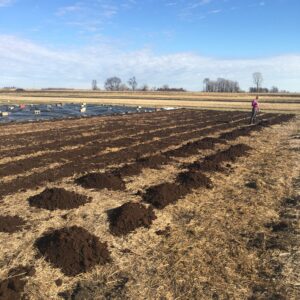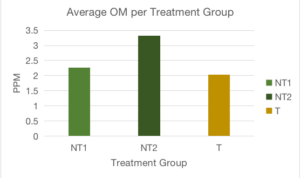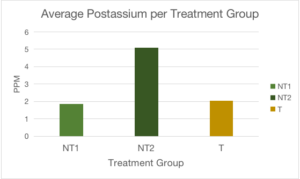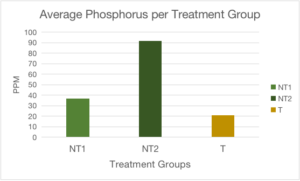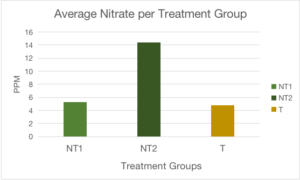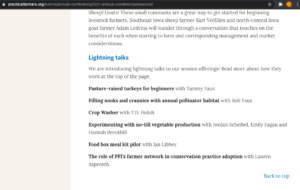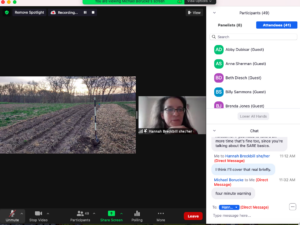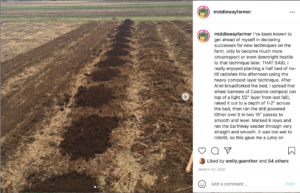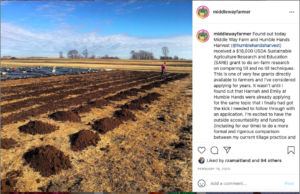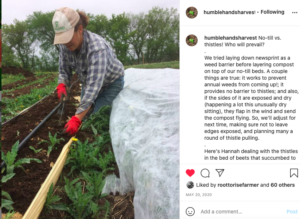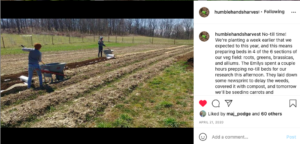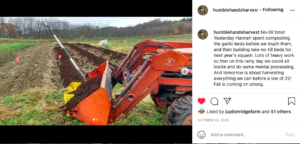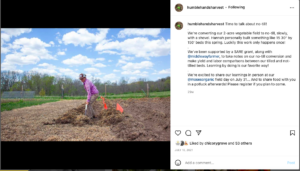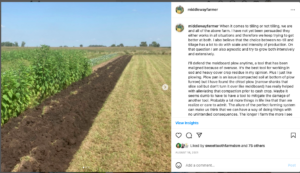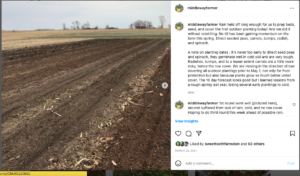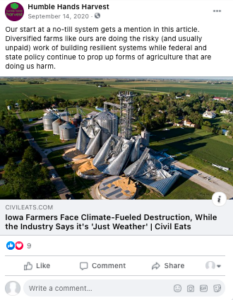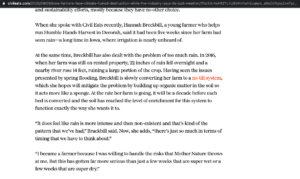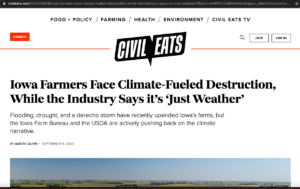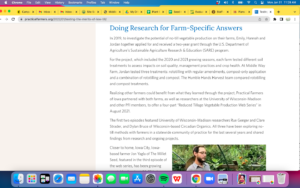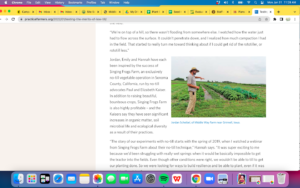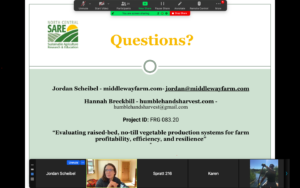Final report for FNC20-1249
Project Information
Humble Hands Harvest (here after HHH) is a worker-owned cooperative farm operating on 22 acres of former conventional crop land in northeast Iowa since 2017. HHH raises grass-finished lamb and pastured pork, is establishing nut and fruit orchards, and cultivates two acres of organic vegetables for direct market sale.
HHH’s two worker-owners are Emily Fagan and Hannah Breckbill, who come from non-farming backgrounds and have bachelor's degrees in physics and mathematics, respectively. In 2017, Emily did extensive labor analysis of their vegetable operation to generate an enterprise budget so that she could determine profitability of different crops. This data has been used for studies through Practical Farmers of Iowa and Iowa State Extension, as well as in our own farm's pricing and decision-making.
HHH regularly invites their community out to the farm to build a culture of connection to the land and food. They have hosted a Queer Farmer Convergence, climate resilience events, numerous field days, and monthly work-day potlucks. Their goal is to create a local center for land-based celebration and culture-building in their community.
Middle Way Farm (here after MWF) consists of 4 acres of leased land just north of Grinnell, Iowa, run by Jordan Scheibel since 2013 with the support of the Lacina family. About 2 acres is currently in annual vegetable production, with another half acre used for propagation greenhouse, high tunnel, and various perennial plantings and orchard. The farm direct markets produce primarily through CSA and farmers market. The farm uses organic growing methods, but is not currently certified organic. Jordan has been farming full time since December 2015.
Jordan brings a strong background in on-farm research as well as education and outreach. Jordan has participated in numerous on-farm trials since 2014 through the Practical Farmers of Iowa’s (PFI) Cooperators program. He has also served on a number of PFI committees, has been a regular attendee of both the PFI annual conference (as well as a presenter twice, and presented again in 2021) and the Midwest Organic Conference since 2011. The farm hosts an annual open house field day in September (advertised through PFI’s field day guide) and has hosted many on-farm workshops and tours over the years, in addition to numerous off-farm presentations. Prior to farming full-time, Jordan was the continuing education coordinator for the local community college district for 4 years, using his farm as a site for several classes he taught.
Organic vegetable farmers in the Midwest are typically reliant on dry soil and tillage to prepare soil for planting. Increasingly wet, erratic springs are making initial soil preparation by rototiller more difficult. Both Humble Hands Harvest and Middle Way Farm have observed that beds raised by tillage prepared in advance of planting have allowed them to plant sooner in the spring and improved drainage during heavy rainfall. Pairing the practice of raised beds with a no-till approach combines the advantages of both systems. Raising the bed facilitates better drainage for quicker access after rain, while no-till creates a more stable, aggregated soil that is less prone to erosion during heavy rain. Both farms would like to explore the feasibility of transitioning their vegetable farms into raised no-till beds over time. The most important question we will explore is how much more labor and resources it takes to create, cultivate, and maintain no-till beds versus our current tractor-tillage systems. We also want to track production and soil quality characteristics between tilled versus no-till beds to see if there is a difference over time. Finally, we will record our qualitative observations of the work involved and problems encountered in each system.
Original Objectives
- Develop no-till systems on each of our farms that enables us to build and maintain beds without a tractor.
- Compare inputs and labor, quantitatively and qualitatively, between no-till and tillage systems.
- Observe production, plant health, and soil health differences between no-till and tillage systems.
- Share results with other vegetable farmers, our customers, and our community.
Year 2 Objectives:
- MWF will maintain the three experimental 5 bed sections (no-till, tilled with compost, and tilled with no compost) using the same practices as 2020, but will begin replicating crops between treatments. For example, a bed of spinach will be planted in each experimental section, for a total of 3 beds of spinach. This will allow for direct comparisons of yield, crop quality, and labor time, which was not possible in 2020 when crops were not replicated between treatments. HHH will continue three crop comparisons from 2020: tilled vs. no-tilled for carrots, kale, and zucchini, measuring yield and labor input between treatments and crops. HHH will discontinue using a paper mulch underneath
- Each farm will evaluate soil health differences between treatments through testing at the end of 2021 and compare with end of 2020 soil test results. Soil testing will include farmer led testing via Midwest Laboratories as well as soil analysis by staff at the Midwest Rodale Institute.
- Outreach activities in 2021 will include Practical Farmers of Iowa (PFI) field days on each farm (virtual or in-person depending on COVID situation), a planned No-Till virtual convergence this summer organized by PFI, and presentations at the PFI conference in January 2022. Both farms will continue to post about their no-till experiments on their social media accounts throughout the season.
Cooperators
- - Producer
Research
HHH’s tilled control beds will be 24” wide (space between tractor tires) with 24” walking paths. To prepare beds, they will spread Sustane fertilizer before tillage. Once crops are finished in a given bed, they will be tilled and planted to winter-kill cover crops.
HHH’s no-till bed system will have 28-inch wide beds with 20-inch walking paths. They will be built by shoveling soil from the walking paths onto the bed, raking the surface of the bed level, and spreading several inches of compost before planting. Once crops are finished in a given bed, crop residue and weeds will be cleared out by hand and the bed will be either winter-kill cover cropped or immediately re-formed with compost and re-planted.
HHH’s control beds and no-till beds will be given the same treatments in the form of mulch and silage tarps.
At MWF, no-till beds will be created by laying 1-2 inches of compost, broadforking, amending, shallowly tilling with a drill powered tilther to incorporate compost and amendments before direct seeding or paper pot transplanting. Silage tarps will be used before, between, and after crops. Beds will be re-composted and covered in silage tarps over the winter.
This no-till approach will be compared alongside two other treatments: 1) BCS rototilling with amendments but without broadforking or compost (MWF’s current bed prep method) and 2) BCS rototilling with amendments and compost but no broadforking. This approach will help isolate the effect of compost application from the effect of reduced tillage on production. Each treatment block will be five beds wide, which matches the width of the silage tarps that will be used on all treatments.
Both farms will use certified organic Cowsmo compost from Wisconsin that they have purchased before, which is made from dairy cow manure and untreated wood waste.
We measured the results of our comparison between tilled and no till systems through soil testing, yield, labor, and weed pressure comparisons, and other anecdotal observations. Middle Way Farm (hereafter MWF) and Humble Hands Harvest (hereafter HHH) gathered both similar and different observations.
Through soil sampling collected in fall 2020,MWF found that the no till with compost plot exhibited better overall soil health quality than either tilled treatment (with compost or without compost). This included higher cation exchange capacity, higher organic carbon, and a better overall soil health calculation. Some indicators did not show much difference between the two treatments with compost, including organic matter and the primary macronutrients of nitrogen, phosphorus, and potassium. These indicators, however, were all lower in the no compost treatment. Between all treatments there was not a strong difference in magnesium, calcium or other micronutrient levels. pH was the one concerning indicator on the no till with compost treatment, since my goal is to keep pH between 6-7. Testing was done by Midwest Laboratories in Omaha, Nebraska.
| Treatment | Organic Matter (%) | C.E.C. | soil pH | Phosphorus (P2 strong bray, ppm) | Potassium (ppm) | Nitrogen (Nitrate-N, lbs/A) | C:N ratio | 1 Day CO2C Burst | Soil Health Calculation (0-25 scale) |
| Tilled, No Compost | 4.1 | 16.3 | 6.7 | 89 | 176 | 14 | 18.2 | 179 | 20.6 |
| Tilled with Compost | 5.1 | 16.7 | 6.8 | 112 | 303 | 25 | 20.9 | 207 | 23.3 |
| No Till with Compost | 4.9 | 17.3 | 7 | 107 | 345 | 27 | 17.1 | 310 | 34.7 |
Humble Hands Harvest received assistance from the Rodale Institute Midwest Organic Center to do soil sampling in both year 1 (2020) and year 2 (2021) of the experimental plots, using AgSource Laboratories in Ellsworth, Iowa. The charts below compare just OM and the three primary nutrients NPK. Comparison results for other indicators including pH, CEC, C:N ratio, etc. were not available for this report. NT1 is the first year of no till results and NT2 is the second year of no till results. The comparisons show a marked gain in OM and NPK during the second year of no till management, with relatively little difference between tilled and no till during the first year of management.
Middle Way Farm observed the following over the course of the 2021 season:
During their 6/7/21 spinach harvest, only the tilled with no compost bed was harvestable because the other plots had bolted. The compost application in the other beds may have pushed along maturity and resulted in earlier bolting. There were also differences in weed pressure observed between the three plots. The tilled with no compost bed was the least weedy. The tilled with compost bed was weedier and had the most broadleaf weed pressure. The no till with compost bed was the weediest and had the most grass weed pressure. The no till plot with compost also had the most bolting of the three.
During their 6/7/21 green top beet harvest, they observed that the tilled with no compost bed had the lowest yield of the three beds. Like the spinach bolting, these seems to indicate that compost application pushes along maturity, which in the case of the beets was desirable while with the spinach, it was less desirable.
During their 7/16/21 green bean harvest, they observed a 33% difference in yield between the no till with compost bed and the tilled with no compost bed. The tilled with compost bed was not picked that day, so we were not able to compare all three beds.
In 2021, HHH did side-by-side comparisons of 3 crops: onions, carrots, and kale.
Onions: In our conventional tillage system, we plant two onion rows per bed so that we can run a wheel hoe down the middle of the bed, several times during the growing season. In a no-till system, we don’t want to step on the bed and so can only use a wheel hoe in the paths. This means that we were able to plant a third row in the onion no-till bed. The no-till bed yielded 220 pounds, and the tilled bed 143 pounds. Yield per bed was therefore 50% higher for no till, with no measurable labor difference (at the beginning of the season, annual weeds in the no-till bed were held back by the compost mulch, which meant that weeding down the bed was a wash compared to wheel hoeing and weeding a tilled bed; by the final weeding of the season, the weeds in the tilled places were too thick to get a wheel hoe through, so both the tilled and no-till beds were hand weeded). We plan to plant all of our onions in no-till beds, 3 rows to a bed (or maybe 4, to minimize the space we have to weed) from now on.
Carrots: our side-by-side carrot planting was our final planting of the year. We seeded carrots on July 1; our tilled planting was in a bed that had been cover cropped up to that point in the season, while our no-till planting went into a bed that had held early-season beets that spring. The tilled carrots strongly outperformed the no-till carrots, in contrast to our experience in 2020: the tilled bed in 2021 produced 234.3 pounds, and the no-till bed produced 99.2 pounds. We were in drought for most of the year, and the drip tape used on the no-till bed was older, so our suspicion is that irrigation was spottier on the no-till bed, and the compost mulch may have wicked moisture away from the carrots. Our early-season carrots were in no-till beds also and performed well, so we don’t have a strong conclusion about carrots in no-till.
Kale: There was no difference in either labor or yield between our kale plantings under the two different treatments. However, this year most of our brassicas were planted in no-till beds and we were really happy with their performance, attributing a lot of it to the composted soil.
Conclusions
In our anecdotal observations, informed by the quantitative data we gathered, Middle Way Farm and Humble Hands Harvest came to different conclusions on the results of our experiments. Humble Hands Harvest concluded that no till production was a better fit for their farm than continued tillage and plans to convert their entire 2 acre production area to no till over the course of the next several years. HHH's initial concern about increased labor using no-till were allayed by the fact that rather than an overall increase in labor, no till required a reallocation of labor towards bed preparation in the beginning of each season (as well as increased bed preparation at the start of the initial no till conversion season), with subsequent labor savings via reduced weeding and better crop quality later in the season. They are still working on an efficient way to spread compost when planting–currently it takes nearly two person-hours per bed. They have been bringing tractor bucket loads of compost to a cart that straddles the bed, and then pulling the cart down the bed, spreading compost with a shovel as we go. It is a slow-going task and is best accomplished with a team of two shovelers and one tractor-runner.
MWF, on the other hand, found the increased labor for bed preparation particularly challenging during mid-season crop successions, which often take place under severe time constraints due to weather and other pressing work. In addition, MWF, unlike HHH, did not see a decreased weed pressure in their no till plots, most likely because their bed preparation method still required some surface disturbance of the soil with a wheel hoe, rake, and/or a tilther, which exposed bare soil under the compost mulch. Finally, MWF did not see as much gains in productivity and soil tilth as they expected under no till management as compared to tilled management (particularly tilled with the addition of compost), which led them to believe that the additional labor for no till bed preparation was not justified. On their initial set-up for their experimental plots, MWF made 30" beds and 18" pathways. This spacing did allow the passage of a tractor down the bed. In subsequent no till bed setup outside of the experimental plots, MWF increased bed width to 36", which allows the tractor tires to drive over and straddle the bed. In this way, compost can be applied to the bed top directly from the tractor bucket, rather than needing to empty the tractor bucket into wheel barrows first.
Both farms used opaque silage tarps to smother annual and perennial weeds (particularly Canada thistle at HHH) in their no till plots and to facilitate bed turnover from one crop to another. While the tarps do help with weed suppression and thus are helpful in the no till context, both farms observed that there is little to no residue breakdown underneath the tarps, which can make subsequent bed prep more labor intensive. Moving, securing against wind, and storing the tarps when not in use also continues to be a challenge on both farms. During our August web series event, one questioner asked why we did use clear plastic to solarize our beds instead of silage tarps. HHH observed that they do use clear plastic to solarize areas on their farm (outside of their no till experiment), and they tend to leave it on longer than their silage tarps. MWF observed that they have seen other farms use clear plastic to quickly solarize a bed and break down residue in order to facilitate a no till bed flip. Both HHH and MWF feel that studying quick solarization through clear plastic as an alternative to silage tarps (particularly because any farm with greenhouses or high tunnels will generally have extra, old clear plastic on hand, rather than needing to buy a silage tarp) is a promising direction for no till research.
One caveat to this conclusion that is shared by both HHH and MWF is that the transition to no till, similar to the transition to organic, requires a more difficult and discouraging adjustment period before the most apparent gains in productivity and soil quality begin to manifest. Both MWF and HHH believe that 2 years is an inadequate window of time to conclusively test no till production versus tilled production and are encouraged that the Rodale Institute Midwest Organic Center in Marion, Iowa is carrying on longer term experiments in comparing tilled and no tilled production accompanied with more robust data collection characteristic of a research farm.
Educational & Outreach Activities
Participation summary:
On January 22, 2021, Hannah of Humble Hands Harvest and Jordan of Middle Way Farm presented for 8 minutes total on "Experimenting with no-till vegetable production" as part of a Lightening Round during Practical Farmers of Iowa's Virtual Annual Conference. We mentioned that our project was funded through SARE, shared photos of our no-till plots, and described the challenges and successes of the season, as well as what we plan to change for next season. The screenshot below shows 49 participants in the Zoom link during Hannah's portion of the presentation.
Over the last 2 years, Humble Hands and Middle Way have made a number of posts about our no-till projects on our social media, as you can see from Instagram screenshots below (all of which were simultaneously posted to Facebook), with a total engagement in 2021 of 380 likes and 25 comments across 6 posts (3 by each farm) on Instagram, and 103 likes and 8 comments across 7 posts (3 by Middle Way Farm, 4 by Humble Hands Harvest) on Facebook. In 2022, we had 299 likes and 33 comments across 5 posts (2 for HHH and 3 for MWF) on Instagram, and 78 likes and 6 comments across 4 posts (2 for HHH, 2 for MWF) on Facebook, for a total engagement across platforms of 377 likes and 39 comments.
In addition, Humble Hands Harvest was also featured in a September 2020 Civil Eats article published online (screenshots below), and posted about that article on Facebook.
Here is the Google Drive link to the presentation we did at the Practical Farmers of Iowa conference in January 2021, which includes more photos and also some notes about our preliminary conclusions.
From 3 - 5 pm on July 30, 2021, Middle Way Farm hosted a "Catching Up" field day for Practical Farmers of Iowa with the title "Investigating Reduced-Till Vegetable Production at Middle Way Farm". 13 participants per Jacqueline Venner Senske, PFI staff - https://practicalfarmers.org/events/field-days/catching-up/
The next day on July 31, 2021, from 2 - 5 pm Humble Hands Harvest hosted a MOSES Organic Field Day at their farm with the title of "Creative Land Access and No-Till Vegetable Research". 25 participants - https://mosesorganic.org/events/organic-field-days/humble-hands-harvest-july-31/
On August 26, 2021, from 6-7 pm Humble Hands Harvest and Middle Way Farm participated in a live webinar including an in field demonstration of no till practices at Middle Way Farm as part of Practical Farmers of Iowa's "Reduced Tillage Production Web Series", in collaboration with other Iowa farmers, Dane County Extension, and University of Wisconsin-Madison. The entire series is published on YouTube by Practical Farmers of Iowa as a permanent resource for farmers. 252 views on YouTube. - https://practicalfarmers.org/2021/08/reduced-tillage-vegetable-production-web-series/
The YouTube video of our webinar can be found directly here.
On January 3, 2022, Practical Farmers of Iowa published an article on our no till project in their quarterly magazine (2800 copies printed and distributed) as well as published online here
Some screenshots from that article, including a mention of the SARE grant:
On January 7, 2022, from 11 - 11:30 am, Humble Hands Harvest and Middle Way Farm presented virtually as part of the SARE Farmer Forum at the Great Plains Growers Conference in St. Joseph, Missouri. Our talk was titled "Experimenting with No-till Vegetable Production." 25 participants - https://www.greatplainsgrowersconference.org/friday-schedule.html
On January 22 from 4:15 - 5:15 pm Humble Hands Harvest and Middle Way Farm presented as part of a panel entitled "Experiences with No Till Vegetable Production" at the Practical Farmers of Iowa conference in Ames, Iowa. We co-presented with fellow farmer Mark Quee of Scattergood Friends School in West Branch, Iowa and Linda Strum-Flores of the Rodale Institute Midwest Organic Center in Marion, Iowa - https://practicalfarmers.org/events/annual-conference/2022-annual-conference/sessions/. 36 participants per Jacqueline Venner Senske, PFI staff
Learning Outcomes
Each farm learned different lessons from this grant. Humble Hands Harvest learned that they prefer no till to tillage and subsequently will be transitioning their entire 2 acres to no till production over the next 2 -3 years. Over the course of the trial Humble Hands Harvest abandoned the use of cardboard with compost over the top and settled on just putting compost on top of bare soil beds. Because the last two years have been drier than average, Humble Hands harvest was not able to fully test whether no till raised beds made a difference in being able to plant earlier and also deal with heavy rains. Middle Way Farm learned that they prefer a hybrid, all of the above approach, using no till in some instances and tillage in others. Over the course of the trial, they learned that matching bed spacing to tractor tires is very important for efficient spreading of compost, initial deep tillage such as a chisel plow followed by rototilling is a good first step when establishing a plot that will subsequently be no till, and that raking residue from no till beds rather than waiting for it to decompose can make the no till bed flip much quicker. Middle Way Farm also found that compost quality has a big influence on the success of no till systems requiring heavy compost application and due to some of the hydrophobic qualities of the Cowsmo compost they used, they saw splitting particularly in root crops that was not observed in either tilled beds. This result in particular led them to believe that when using a compost like Cowsmo, heavy applications should probably be tilled in to avoid these kinds of issues. Middle Way Farm will continue to experiment with no till production beds on a limited basis as we have time and capacity in order to refine our system and consider whether to more fully implement it on other areas of our farm.
In our original proposal, we framed our experiment with no till largely around dealing with wet springs and inadequate drainage after heavy rains. Both farms found that no till raised beds did allow earlier spring bed preparation, better access to the field during wet periods, and were better armored against erosion during heavy rain events. Given that we went through two dry years, we don't think we saw our best test of no till's ability to withstand wet weather better than tilled soils. HHH in particular has found that no till is going to be a central part of their goal of building more climate resiliency into their farm. Two other issues with tillage that MWF hoped to address with no till was soil crusting after heavy rains on tilled soil and compaction layers from tillage. During year one, MWF struggled with unaddressed compaction in the no till soil that hindered production - stunted and split roots as well as uneven germination from the Earthway seeder skipping on clods. Better results on all fronts were seen in year two, but addressing the underlying compaction FIRST, before beginning no till, is one of the more important conclusions from this project. As for soil crusting, we had fewer issues with this in all treatments than we have had in previous years. Where compost stays completely on top of soil, it does armor the soil against heavy rains that typically lead to crusting, and the compost remains more friable after getting wet and drying out. However, if the compost is mixed into the soil by wheel hoe or tilther, this effect is partially compromised. Combining compost and tillage seems to give some of the effects of both treatments - better soil health characteristics but more easily worked soil.
The advantages we found for no till were generally more windows and flexibility for bed preparation especially earlier in the season, better soil health characteristics, less weeding for HHH using a thick undisturbed compost mat (not for MWF), sometimes better yields depending on crop and season, and an accumulating soil structure that is not wrecked yearly or multiple times a year by tillage. The disadvantages of no till appear to be increased manual labor for bed preparation especially early in the season, the expense and labor of spreading compost, difficulty with seeding and growing root crops particularly but not limited to carrots, persistence of perennial difficult to control weeds, and extra time for bed flips by hand or using a silage tarp. All of these disadvantages have possible mitigation strategies and all are areas for possible refinement of no till practices. Ultimately the main limitation with compost based no till practices is that they are most suitable for small scale intensive production and are not applicable to broad acre crops or mechanization. There are interesting developments in small scale mechanization of common no till practices such as broad forking and compost spreading that may lead to small but significant gains in efficiency if widely adopted.
Our primary recommendations for a farmer considering moving towards no till vegetable production would be to 1) consider at least vertical tillage first to alleviate compaction, 2) source high quality compost, 3) make compost spreading as easy and efficient as possible (mechanized if possible), 4) start small and expand year by year as you see results, and 5) don't expect huge results in your first year or two.
Project Outcomes
We believe that no till is best studied as a long term project, greater than 2 years. We think that the benefits of no till likely accrue and snowball over time, meaning that there will be less difference in yield, crop quality, etc. during the first transition years but that these differences will grow over time in favor of no till.
Sourcing and purchasing high quality bulk compost is one of the stumbling blocks for no till vegetable production that uses heavy applications of compost for weed suppression and to create tilth. On farm production of high quality compost would appear to be the answer but relatively few vegetable farms are making their own compost. On our own farms, we simply don't have the time or expertise to manage our compost piles intensively enough to produce the weed free, disease free, thermo-phillic compost we need. There are also no suppliers of organic, high quality compost in Iowa, meaning that we had to purchase compost from Wisconsin. We would like to see more smaller scale compost businesses that can supply growers in Iowa.
We think that there is further research warranted concerning the difference between using opaque silage tarps versus clear plastic to occultate versus solarize no till beds to kill weeds and break down residue. Silage tarps appear to take longer and result in less residue breakdown than using clear plastic to quickly solarize a bed. Bryan O'Hara of Tobacco Road Farm in Connecticut would be a farm to model off of for using clear plastic to solarize no till beds.
Doing a lot of data collection during the growing season is difficult for a number of reasons, particularly doing yield comparisons across beds with multiple people harvesting but also tracking labor and dividing it between experimental plots in the midst of a busy work day. Whenever possible, we think it's best to have farmers partner with educational institutions and non-profit institutions to help them with data collection and analysis so that they can focus on pulling off the production side of things. Employees on the farm should be, as much as possible, brought into collaboration in the experiment so that they can meaningfully contribute to the project. We think for our grant in particular if we were to do it over again we would do a smaller comparison, just one bed per experimental plot instead of five beds per experimental plot. We think this would have facilitated better data collection and comparisons and decreased the overall complexity of the undertaking.
